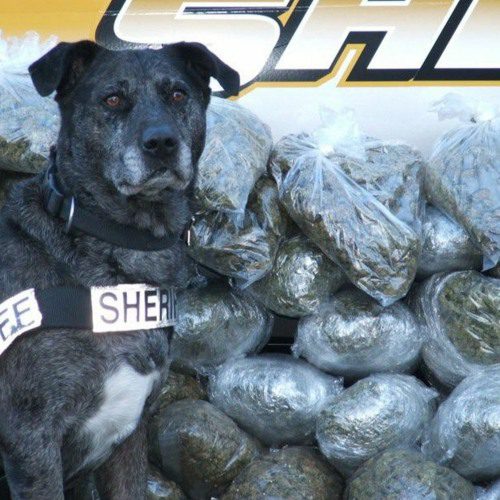
Man’s Best Friend or Enemy? Drug Dogs: The Real Story
Police officers use a range of aides in their effort in the war on drugs, but none are as controversial as man’s best friend. The Department has used canines to sniff out bombs since 1940 and incorporated illegal substances by the seventies. Dogs are used in airports, traffic stops, and school searches, but this begs the question: How do they do it? Dogs are not born with the innate ability to alert someone when they smell marijuana, ingredients for methamphetamine, or a bomb, they are trained to perform a job.
Whether it is a treat or a belly scratch, the main ingredient in positive reinforcement is the outward show of approval from their owner that they interpret based on their owner’s tone of voice. Dogs have no sense of right and wrong. The conditioning they undergo is not simply, “tell me if there is this smell” it is “if I find this smell, my owner is really happy with me, I like it when he’s happy with me.”
Dogs feed off of the body language of their owner; they want their owner to be happy with them, and in this instance, officers are happy when their dog confirms their suspicion. Because remember, dogs aren’t used in every single traffic stop, they are only called in when an officer has a reason to believe there are drugs inside the vehicle. The unconscious body language that results from this belief can easily be perceived by one of the most sensitive creatures in the animal world.

A dog’s sense of smell is twenty-five times better than ours, which allows them to separate smells. Unlike humans who smell stew as the wonderful mix of ingredients it is, a dog smells it as meat, broth, carrots, potatoes, and cabbage. This is how the dogs are able to sniff out drugs despite being wrapped with dryer sheets, inside of a coffee can, or inside a gas tank. The dog smells this as dryer sheets, coffee, gas, and marijuana. During training, the dogs are trained using a tennis ball with drugs inside, or a plastic baggy.
An article by expert Barry Cooper says dogs may even be trained to detect the presence of marijuana in as little as one day. The problem, however, is that the discrimination training is often incomplete or missing altogether. Discrimination training is conditioning the dog to differentiate between marijuana and a tennis ball or plastic bag. As a result, there is no definite way to tell if the dog is alerting to an illegal drug or the tennis bag in the backseat.
A University of California study provided a glimpse into the proficiency of K-9 training and the results were staggering. Only 44% of the drugs were correctly alerted, and the dogs alerted correctly in only 27% of searches involving Hispanic men. Keeping these numbers in mind, the 2013 Supreme Court case Florida v. Harris established that a positive alert by a certified drug dog constituted valid probable cause so that an officer may search a vehicle without a warrant. If that does not scream a 4th amendment violation now, we can only imagine what will happen following the new marijuana legislation that already has twenty-three states on board.
The Supreme Court held that a lack of a completed record of the dog’s false positive alerts and training would result in an invalid search. However, the problem with this is, there is no way to verify the search because the dog still cannot talk, and is recorded by the officer whose reasonable belief is confirmed by the dog’s alert. In the event of a false alert, most officers rely on the “residue” excuse, saying there must be some trace forms that caused the dog to alert. If “residue” is all it takes to allow a vehicle search, then lawful recreational or medicinal activities will result in an unlawful search or the lay-off of an entire drug dog population. The inadequacies in the dog’s initial training create genuine concern should there be any attempt to retrain.
In order to try to avoid falling victim to an encounter with a drug dog, drivers are encouraged to maintain their car according to state regulations, obey speed limits and follow the marijuana laws of their state carefully. In the event you do find yourself face to face with a drug dog, respectfully inform the officer that you are aware of the proper drug dog alert protocol and ask to see the dog’s records. At the very least, they are more likely to follow the procedure more closely when they know someone is watching. Looks like the man’s best friend just got a lot less friendly.
via theleafonline.com
Subscribe To Our Magazine!
Get every issue of Psychedelic Magazine delivered straight to your inbox every month - for free! We do not spam!
You have subscribed successfully!
Some error occured
Please fill all the required * fields.








